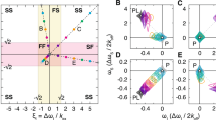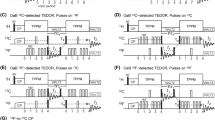Summary
The assignments of the 1H, 15N, 13CO and 13C resonances of recombinant human basic fibroblast growth factor (FGF-2), a protein comprising 154 residues and with a molecular mass of 17.2 kDa, is presented based on a series of three-dimensional triple-resonance heteronuclear NMR experiments. These studies employ uniformly labeled 15N- and 15N-/13C-labeled FGF-2 with an isotope incorporation >95% for the protein expressed in E. coli. The sequence-specific backbone assignments were based primarily on the interresidue correlation of Cα, Cβ and Hα to the backbone amide 1H and 15N of the next residue in the CBCA(CO)NH and HBHA(CO)NH experiments and the intraresidue correlation of Cα, Cβ and Hα to the backbone amide 1H and 15N in the CBCANH and HNHA experiments. In addition, Cα and Cβ chemical shift assignments were used to determine amino acid types. Sequential assignments were verified from carbonyl correlations observed in the HNCO and HCACO experiments and Cα correlations from the carbonyl correlations observed in the HNCO and HCACO experiments and Cα correlations from the HNCA experiment. Aliphatic side-chain spin systems were assigned primarily from H(CCO)NH and C(CO)NH experiments that correlate all the aliphatic 1H and 13C resonances of a given residue with the amide resonance of the next residue. Additional side-chain assignments were made from HCCH-COSY and HCCH-TOCSY experiments. The secondary structure of FGF-2 is based on NOE data involving the NH, Hα and Hβ protons as well as 3JH n Hα coupling constants, amide exchange and 13Cα and 13Cβ secondary chemical shifts. It is shown that FGF-2 consists of 11 well-defined antiparallel β-sheets (residues 30–34, 39–44, 48–53, 62–67, 71–76, 81–85, 91–94, 103–108, 113–118, 123–125 and 148–152) and a helix-like structure (residues 131–136), which are connected primarily by tight turns. This structure differs from the refined X-ray crystal structures of FGF-2, where residues 131–136 were defined as β-strand XI. The discovery of the helix-like region in the primary heparin-binding site (residues 128–138) instead of the β-strand conformation described in the X-ray structures may have important implications in understanding the nature of heparin-FGF-2 interactions. In addition, two distinct conformations exist in solution for the N-terminal residues 9–28. This is consistent with the X-ray structures of FGF-2, where the first 17–19 residues were ill defined.
Similar content being viewed by others
References
Ago H., Kitagawa Y., Fujishima A., Matsuura Y. and Katsube Y. (1991) J. Biochem. 110, 360–363.
Archer S.J., Vinson V.K., Pollard T.D. and Torchia D.A. (1993) Biochemistry, 32, 6680–6687.
Baird A. and Bohlen P. (1990) In Peptide Growth Factors and their Receptors (Eds., Sporn M. and Sporn R.) Springer, New York, NY, pp. 369–418.
Basilico C. and Moscatelli D. (1992) Adv. Cancer Res., 59, 115–165.
Bax A., Clore G.M., Driscoll P.C., Gronenborn A.M., Ikura M. and Kay L.E. (1990) J. Magn. Reson., 87, 620–627.
Bax A. and Pochapsky S.S. (1992) J. Magn. Reson., 99, 638–643.
Carr M.D., Birdsall B., Frenkiel T.A., Bauer C.J., Jimenez-Barbero J., Polshakov V.I., McCormick J.E., Roberts G.C.K. and Feeney J. (1991) Biochemistry, 30, 6330–6341.
Clore G.M. and Gronenborn A.M. (1989) Crit. Rev. Biochem. Mol. Biol., 24, 479–564.
Clore G.M. and Gronenborn A.M. (1991a) J. Mol. Biol., 221, 47–53.
Clore G.M. and Gronenborn A.M. (1991b) Prog. NMR Spectrosc., 23, 43–92.
Clore G.M., Wingfield P.T. and Gronenborn A.M. (1991) Biochemistry, 30, 2315–2323.
Delaglio F., Grezesiek S., Vuister G.W., Zhu G., Pfeifer J. and Bax A. (1995) J. Biomol. NMR, 6, 277–293.
Eriksson A.E., Cousens L.S., Weaver L.H. and Matthews B.W. (1991) Proc. Natl. Acad. Sci. USA, 88, 3441–3445.
Folkman J. and Klagsbrun M. (1987) Science, 235, 442–447.
Friedrichs M.S., Mueller L. and Wittekind M. (1994) J. Biomol. NMR, 4, 703–726.
Garrett D.S., Powers R., Gronenborn A.M. and Clore G.M. (1991) J. Magn. Reson., 95, 214–220.
Gospodarowicz D. and Cheng J. (1986) J. Cell. Physiol., 128, 475–484.
Grzesiek S. and Bax A. (1992a) J. Magn. Reson., 99, 201–207.
Grzesiek S. and Bax A. (1992b) J. Magn. Reson., 96, 432–440.
Grzesiek S., Anglister J. and Bax A. (1993) J. Magn. Reson. Ser. B., 101, 114–119.
Grzesiek S. and Bax A. (1993) J. Biomol. NMR, 3, 185–204.
Ikura M., Kay L.E. and Bax A. (1991) J. Biomol. NMR, 1, 299–304.
Kabsch W. and Sander L. (1983) Biopolymers, 22, 2577–2637.
Kay L.E., Ikura M., Tschudin R. and Bax A. (1990) J. Magn. Reson., 89, 496–514.
Li L.Y., Safran M., Aviezer D., Boehlen P., Seddon A.P. and Yayon A. (1994) Biochemistry, 33, 10999–11007.
Margalit H., Fischer N. and Ben-Sasson S.A. (1993) J. Biol. Chem., 268, 19228–19231.
Marion D., Ikura M., Tschudin R. and Bax A. (1989a) J. Magn. Reson., 85, 393–399.
Marion D., Driscoll P.C., Kay L.E., Wingfield P.T., Bax A., Gronenborn A.M. and Clore G.M. (1989b) Biochemistry, 28, 6150–6156.
Marion D., Kay L.E., Sparks S.W., Torchia D.A. and Bax A. (1989c) J. Am. Chem. Soc., 111, 1515–1517.
Miyamoto M., Naruo K.-I., Seko C., Matsumoto S., Kondo T. and Kurokawa T. (1993) Mol. Cell. Biol., 13, 4251–4259.
Moy F.J., Lowry D.F., Matsumura P., Dahlquist F.W., Krywko J.E. and Domaille P.J. (1994) Biochemistry, 33, 10731–10742.
Pantoliano M.W., Horlick R.A., Springer B.A., VanDyk D.E., Tobery T., Wetmore D.R., Lear J.D., Nahapetian A.T., Bradley J.D. and Sisk W.P. (1994) Biochemistry, 33, 10229–10248.
Pineda-Lucena A., Nunez de Castro I., Lozano R.M., Munoz-Willery I. and Zazo M. (1994a) Eur. J. Biochem., 222, 425–431.
Pineda-Lucena A., Jimenez M.A., Nieto J.L., Rico M. and Gimenez G.G. (1994b) J. Mol. Biol., 242, 81–98.
Powers R., Gronenborn A.M., Clore G.M. and Bax A. (1991a) J. Magn. Reson., 94, 209–213.
Powers R., Clore G.M., Bax A., Garrett D.S., Stahl S.J., Wingfield P.T. and Gronenborn A.M. (1991b) J. Mol. Biol., 221, 1081–1090.
Powers R., Garrett D.S., March C.J., Frieden E.A., Gronenborn A.M. and Clore G.M. (1992) Biochemistry, 31, 4334–4346.
Reiland J. and Rapraeger A.C. (1993) J. Cell. Sci., 105, 1085–1093.
Roghani M. and Moscatelli D. (1992) J. Biol. Chem., 267, 22156–22162.
Saksela O., Moscatelli D., Sommer A. and Rifkin D.B. (1988) J. Cell Biol., 107, 743–751.
Seavey B.R., Farr E.A., Westler W.M. and Markley J.L. (1991) J. Biomol. NMR, 1, 217–230.
Seddon A.P., Decker M., Muller T., Armellino D., Kovesdi I., Gluzman Y. and Böhlen P. (1991) Ann. New York Acad. Sci., 638, 98–108.
Shirakawa M., Fairbrother W.J., Serikawa Y., Ohkubo T., Kyogoku Y. and Wright P.E. (1993) Biochemistry, 32, 2144–2153.
Sklenář V., Piotto M., Leppik R. and Saudek V. (1993) J. Magn. Reson. Ser. A., 102, 241–245.
Sommer A. and Rifkin D.B. (1989) J. Cell. Physiol., 138, 215–220.
Soteriou A., Carr M.D., Frenkiel T.A., McCormick J.E., Bauer C.J., Sali D., Birdsall B. and Feeney J. (1993) J. Biomol. NMR, 3, 535–546.
Spera S. and Bax A. (1991) J. Am. Chem. Soc., 113, 5490–5492.
Thompson L.D., Pantoliano M.W. and Springer B.A. (1994) Biochemistry, 33, 3831–3840.
Vuister G.W. and Bax A. (1993) J. Am. Chem. Soc., 115, 7772–7777.
Westall F.C., Rubin R. and Gospodarowicz D. (1983) Life Sci., 33, 2425–2429.
Yayon A., Klagsbrun M., Esko J.D., Leder P. and Ornitz D.M. (1991) Cell, 64, 841–848.
Zhang J., Cousens L.S., Barr P.J. and Sprang S.R. (1991) Proc. Natl. Acad. Sci. USA, 88, 3446–3450.
Zhu X., Komiya H., Chirino A., Faham S., Fox G.M., Arakawa T., Hsu B.T. and Rees D.C. (1983) Science, 251, 90–93.
Author information
Authors and Affiliations
Rights and permissions
About this article
Cite this article
Moy, F.J., Seddon, A.P., Campbell, E.B. et al. 1H, 15N, 13C and 13CO assignments and secondary structure determination of basic fibroblast growth factor using 3D heteronuclear NMR spectroscopy. J Biomol NMR 6, 245–254 (1995). https://doi.org/10.1007/BF00197806
Received:
Accepted:
Issue Date:
DOI: https://doi.org/10.1007/BF00197806




